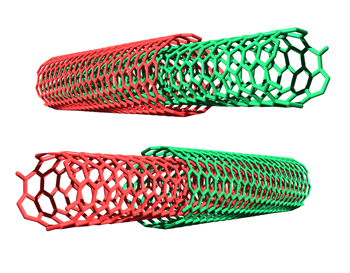Research
SOLAR CELLS
.jpg) |
Single Walled Carbon Nanotubes in Solar Cells
Currently one of the biggest problems facing organic solar cell systems is a short exciton diffusion length of around 5 – 10 nm leading to reductions in efficiency. In our research we attempt to resolve this problem with the use of a nanomaterial known as single-walled carbon nanotubes, which have been estimated to have an exciton diffusion length of 0.1 – 1 µm. Aditionally, due to extraordinary optical and electronic properties the carbon nanotube can be used not only as an efficient method to dissociate excitons but also as the photoactive or light absorbing component. By tailoring the chirality and diameter of the single-walled carbon nanotube the band gap and thereby wavelength of light required for exciton generation can also be tuned. Hence resulting in carbon nanotubes being also ideal for use in sensor devices, where individual chiralities allow for wavelength specific light absorption, or broadband solar cell devices from controlled mixtures of chirality. |
SINGLE-WALLED CARBON NANOTUBES
 |
Prepartion of (n,m) Sorted Single-Walled Carbon Nanotubes
In order to gain access to the richly varying optical properties of SWCNTs it is necessary to develop new methods for the separation of individual (n,m) species from the raw material. Furthermore, if SWCNTs are to be used for devices such as solar cells, any (n,m) separation method must be scaleable to large volumes. In this regard we have developed a method utilising automated gel permeation chromatography system and controllable pH gradients to prepare highly pure (n,m) SWCNT suspensions. |
DOUBLE-WALLED CARBON NANOTUBES
 |
Double-Walled Carbon Nanotubes for Sensor Applications
Double walled carbon nanotubes (DWCNTs) are a unique intermediate between single-walled carbon nanotubes (SWCNTs) and multi-walled carbon nanotubes (MWCNTs) and are therefore of fundamental interest to the carbon nanotube community. This is especially true in the development of advanced biosensors, where the integration of a bio-sensitive element to a nanotube is often necessary. Compared to SWCNTs, where integration of a biomolecule results in disruption of the pristine sp2 hybridized network and subsequent modification of the nanotubes intrinsic properties, it is proposed that covalent modification of a DWCNTs can be performed solely on the outer-wall with the inner-wall remaining pristine for signal transduction. |
